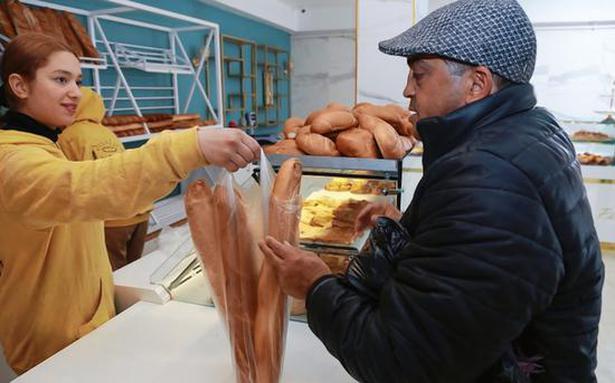The International Monetary Fund (IMF) said in March that the conflict would be a severe blow to the global economy, which would hamper growth and raise prices.
The International Monetary Fund (IMF) said in March that the conflict would be a severe blow to the global economy, which would hamper growth and raise prices.
The ongoing conflict between Russia and Ukraine will reportedly have a major impact on the global economy, which is just recovering from the strains of the coronavirus pandemic.
The International Monetary Fund (IMF) had previously warned that both Russia and Ukraine are major commodity producers and disruptions there have pushed up global prices, particularly oil and natural gas. With Ukraine and Russia accounting for up to 30% of global wheat exports, food prices have also skyrocketed. The IMF added that the entire global economy would feel the effects of slower growth and faster inflation.
The World Bank also said in its spring 2022 economic update for Europe and Central Asia that the conflict delivered a second major shock to the global economy in two years and caused a humanitarian catastrophe. “Even before the war, the global recovery was already slowing, along with deepening geopolitical tensions, ongoing COVID-19 flare-ups, waning macroeconomic support and ongoing supply shortages,” she noted.
poverty and hunger
The World Bank’s baseline forecast projects poverty in Ukraine to increase from 1.8% in 2021 to 19.8% in 2022, based on the $5.50 per day threshold. She added that models developed by the United Nations indicated that a more severe and protracted war could be a possibility leading to poverty affecting almost 30% of the population. Citing estimates by authors of a blog from the Center for Global Development, the World Bank said the recent rise in food prices could push another 40 million people below the $1.90-a-day poverty line.
The IMF expressed similar concerns. In March, it said: “More significant increases in food and fuel prices could lead to a greater risk of civil unrest in some regions, from sub-Saharan Africa and Latin America to the Caucasus and Central Asia, while food insecurity is likely to continue to rise in parts of Africa and the Middle East.” The conflict disrupted the planting and harvesting season in Ukraine and destroyed key fields, storage, infrastructure and manufacturing, particularly in eastern Ukraine. In addition, the conflict has resulted in the halting of shipping from the Black Sea, from where about 90% of Ukraine’s grain is exported.
Referring to the Middle East and North Africa, she had stated that rising prices could lead to social tensions, particularly in countries with weaker social safety nets, fewer job opportunities, limited fiscal space and unpopular governments. This extends to Egypt, which imports about 80% of its wheat from Russia and Ukraine.
In addition, the IMF noted that food pressures in Asia should be alleviated by local production and a greater reliance on rice over wheat. “Costly food and energy imports will push up consumer prices, although subsidies and price caps on fuel, food and fertilizer could mitigate the immediate impact – but at a fiscal cost,” it said.
energy trading
Energy is the “key spillover channel” for Europe, with Russia being a major supplier of natural gas. The World Bank noted that European natural gas price increases have been particularly sharp due to limited spare capacity, including import and export terminals, and the restriction that natural gas must be transported as liquefied natural gas.
According to the IMF, economies that depend on oil imports would experience larger budget and trade deficits, as well as higher inflationary pressures. However, exporters in the Middle East and Africa could benefit from higher prices. In the longer term, the war could fundamentally alter the global economic and geopolitical order, with supply chain reconfiguration, payment network fragmentation, a shift in energy trade and countries rethinking reserve currency holdings, it said.
Amid ongoing tensions, reluctance to buy Russian oil meant the price of the Urals traded at a discount of more than $20/barrel. compared to Brent. “In late March, the price of Brent crude dipped slightly to over $100/barrel, with the price falling after the United States announced plans to release about 1 million barrels of oil daily from its reserves for a period of six months,” states the World Bank. On Monday, Brent crude fell 3% to below $100 a barrel.
According to the International Energy Agency, “Oil prices were already rising before the war, along with a rebound in demand that accompanied the global economic recovery and after supply concerns resurfaced as OPEC+ production fell short of expectations amid limited spare capacity.”
commodity trading
The IMF says that in addition to rising fuel prices, major supply chain disruptions may also result. Disruptions, sanctions and higher commodity prices also have the potential to disrupt global value chains. This could exacerbate ongoing stresses and contribute to extended delivery times and high production costs for manufacturers around the world, the World Bank report said.
Although Russia and Ukraine together account for less than 3% of global exports and less than 2% of global imports, the tax authority adds, the conflict and subsequent sanctions have disrupted trade connectivity by disrupting transit routes, particularly for sea container traffic and air cargo, frayed traffic. Additionally, higher fuel prices and insurance premiums have pushed up shipping costs.
Supply chains for high-value goods and critical components, including those in the automotive and electronics industries, suffered particularly from disruptions in the trade corridor between Europe and Asia. The World Bank said the war cut off European automakers from supplying vital parts like Ukrainian-made wiring systems. This has stopped some assembly lines. Bottlenecks have also impacted industries such as food, construction, petrochemicals and transportation.
services and travel
The World Bank also pointed to the global impact on trade in services as international travel has been disrupted by airspace closures, travel restrictions, sanctions and increased fuel prices. Russia and Ukraine are among the top 10 countries for total global departures and are a major source of revenue for tourism-dependent countries in Europe, East Asia and the Pacific, the Middle East, North Africa and South Asia.
“The war is likely to stall the post-pandemic recovery of international tourism, already anemic from the ongoing disruptions from COVID-19. A further intensification of geopolitical tensions could trigger a renewed decline in international tourism that would likely resemble the sharp decline and subsequent weak recovery after 9/11,” she noted.
Debt Reservation and Financing
In March, the World Bank pointed out the high level of debt in emerging and developing countries. It is estimated that these economies account for around 40% of global GDP. The dilemma for policymakers was to balance between containing inflation and preserving the post-pandemic economic recovery.
She added that geopolitical tensions have “darkened the outlook” for developing countries that are major commodity importers or depend on tourism or remittances. Citing the situation across Africa, external borrowing costs are rising while bond spreads widen by an average of 20 basis points.
In addition, the calculus has suddenly changed for countries with high debt, limited reserves and short-term payments, such as Sri Lanka, which was considering IMF financing to service its debt burden.
Financial spillovers are most likely to be felt in advanced economies with exposure to Russian financial assets, including some Italian, French and Austrian banks, according to the World Bank. Your involvement in the economy of the sanctioned country is through business relationships and local presence. “As a result, European bank stocks have lost more than a fifth of their value since the start of the war, but high capital adequacy and liquidity ratios have cushioned the impact,” says the same report.




